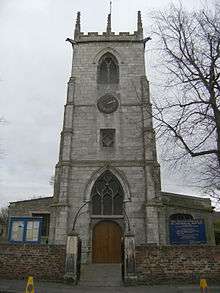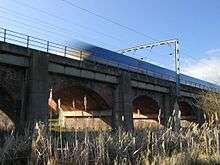Bawtry
Bawtry is a market town and civil parish sited where the western branch of the Roman Ermine Street crosses the River Idle in the Metropolitan Borough of Doncaster, South Yorkshire, England, close to its boundary with Nottinghamshire, and meets the old course of the Great North Road. Nearby towns include Gainsborough to the east, Retford to the south-south-east, Worksop to the south-west and Doncaster to the north-west. Historically in the West Riding of Yorkshire, its population of 3,204 in the 2001 UK census[1] rose to 3,573 in the 2011 Census.[2]
| Bawtry | |
|---|---|
 Bawtry Location within South Yorkshire | |
| Population | 3,573 (2011 Census) |
| OS grid reference | SK6593 |
| Civil parish |
|
| Metropolitan borough | |
| Metropolitan county | |
| Region | |
| Country | England |
| Sovereign state | United Kingdom |
| Post town | Doncaster |
| Postcode district | DN10 |
| Dialling code | 01302 |
| Police | South Yorkshire |
| Fire | South Yorkshire |
| Ambulance | Yorkshire |
| UK Parliament | |
Location


Bawtry is located in the metropolitan borough of Doncaster on the border with Nottinghamshire, and is situated between Bircotes and Misson at the conjunction of the A614, A631 and A638 roads. The present A638 was for centuries the Great North Road. In the 20th century the town became a notorious bottleneck, until it was bypassed in 1965. The county boundary with Nottinghamshire runs just to the south of the town – the southernmost house on the Great North Road names itself "Number One Yorkshire".
The town's former prosperity was based on communications: the River Idle when it was a port, the Great North Road in the coaching era, and the Great Northern Railway. Its geographical location is 53° 25' 40" North, 1° 1' West, at an elevation of some 65 feet (20 m) above sea level.
The town lies just south of Doncaster Sheffield Airport, formerly RAF Finningley. Bawtry Hall was home to RAF No.1 Group Bomber Command during and after the Second World War, and became the headquarters of RAF Strike Command (see RAF Bawtry). From 1989 to 2013 Bawtry Hall operated as a Christian conference centre and a base for several Christian bodies.
Toponymy
The origin of the name "Bawtry" is uncertain, but it is thought to contain the Old English words ball ("ball") and trēow ("tree"), so meaning it was a "(place at) ball-shaped tree". It was not mentioned in the Domesday Book, but recorded as Baltry in 1199[3] and Bautre on a 1677 map.[4]
Bawtry was originally a Roman settlement located on Ermine Street between Doncaster and Lincoln. In AD 616, the Anglo-Saxon King Aethelfrith met his end in battle against Raedwald King of East Anglia, by the River Idle at Bawtry. The site in Aethelfrith's time lay in the southern reaches of Northumbria, a dangerous marshy region close to the border with Lindsey and easily accessible from the Kingdom of East Anglia.
A settlement developed around a wharf in the Danelaw era. Evidence suggests that St Nicholas's Church was first erected in this period. While the village originally lay in Nottinghamshire, boundary changes before the Norman conquest moved it just inside the West Riding of Yorkshire.[5]
Around 1200, a new town was developed adjacent to the older village, by either John de Busli or Robert de Vipont. In 1213, de Vipont received a royal charter declaring an annual four-day fair at Pentecost, and a market was first recorded in 1247. The town grew as a river port, and as a local commercial centre and stopping point between Doncaster and Retford. By the mid-14th century, the port was exporting wool and other items overseas, and the Hospital of St Mary Magdalene was founded, which survived until the 18th century.[5]
Trade declined and by the 1540s John Leland recorded it as being "very bare and pore", but it grew again in the Elizabethan period with the export of millstones.[5]
Bawtry has a school called Bawtry Mayflower School named after the vessel Mayflower, which took William Bradford, leader of the Pilgrims, to the Americas, settling the first Plymouth Colony. Bradford lived at Austerfield, hardly a mile from Bawtry.
The White Hart in Swan Street is the oldest surviving pub in Bawtry, dating back to 1689. The older Swan Inn, also in Swan Street, has been converted to other uses. South Parade is a terrace of Georgian houses.
The Market Hill and High Street contain other buildings of that period, interspersed with more recent development. One feature in the High Street is The Crown Hotel, a former coaching inn,[6] which has accommodated the likes of Ronan Keating and Billy Connolly in the past [7].
The Courtyard in Bawtry is a modern development housing shops and businesses. The development by Graham Smith Design went on to win the "Green Apple Awards 2005", in recognition of its efforts to preserve and enhance the town's heritage.
See also
References
- Office for National Statistics: Census 2001: Parish Headcounts: Doncaster Archived 13 June 2011 at the Wayback Machine Retrieved 26 August 2009.
- "Civil Parish population 2011". Neighbourhood Statistics. Office for National Statistics. Retrieved 6 March 2016.
- 'Oxford Dictionary of British Place-Names', A. D. Mills, Oxford University Press.
- 'A Mapp of Nottingham Shire with its Devisions and Wapontakes Described', Dr.(?) Roberto Southwell, 1677.
- David Hey, Medieval South Yorkshire
- http://www.visitdoncaster.com/where-to-stay/crown-hotel-bawtry
- https://www.lincolnshirelive.co.uk/news/local-news/historic-hotel-used-billy-connolly-380840